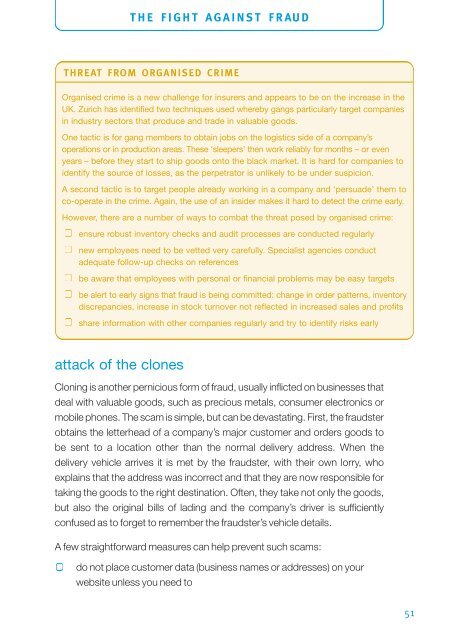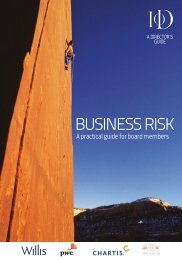risk management - Director Magazine
risk management - Director Magazine
risk management - Director Magazine
You also want an ePaper? Increase the reach of your titles
YUMPU automatically turns print PDFs into web optimized ePapers that Google loves.
THE FIGHT AGAINST FRAUD<br />
THREAT FROM ORGANISED CRIME<br />
Organised crime is a new challenge for insurers and appears to be on the increase in the<br />
UK. Zurich has identified two techniques used whereby gangs particularly target companies<br />
in industry sectors that produce and trade in valuable goods.<br />
One tactic is for gang members to obtain jobs on the logistics side of a company’s<br />
operations or in production areas. These ‘sleepers’ then work reliably for months – or even<br />
years – before they start to ship goods onto the black market. It is hard for companies to<br />
identify the source of losses, as the perpetrator is unlikely to be under suspicion.<br />
A second tactic is to target people already working in a company and ‘persuade’ them to<br />
co-operate in the crime. Again, the use of an insider makes it hard to detect the crime early.<br />
However, there are a number of ways to combat the threat posed by organised crime:<br />
ensure robust inventory checks and audit processes are conducted regularly<br />
new employees need to be vetted very carefully. Specialist agencies conduct<br />
adequate follow-up checks on references<br />
be aware that employees with personal or financial problems may be easy targets<br />
be alert to early signs that fraud is being committed: change in order patterns, inventory<br />
discrepancies, increase in stock turnover not reflected in increased sales and profits<br />
share information with other companies regularly and try to identify <strong>risk</strong>s early<br />
attack of the clones<br />
Cloning is another pernicious form of fraud, usually inflicted on businesses that<br />
deal with valuable goods, such as precious metals, consumer electronics or<br />
mobile phones. The scam is simple, but can be devastating. First, the fraudster<br />
obtains the letterhead of a company’s major customer and orders goods to<br />
be sent to a location other than the normal delivery address. When the<br />
delivery vehicle arrives it is met by the fraudster, with their own lorry, who<br />
explains that the address was incorrect and that they are now responsible for<br />
taking the goods to the right destination. Often, they take not only the goods,<br />
but also the original bills of lading and the company’s driver is sufficiently<br />
confused as to forget to remember the fraudster’s vehicle details.<br />
A few straightforward measures can help prevent such scams:<br />
do not place customer data (business names or addresses) on your<br />
website unless you need to<br />
51









